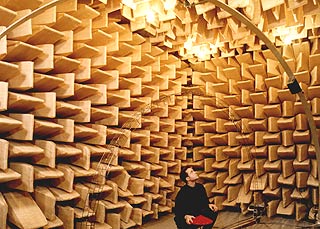
Acoustic anechoic chambers are used for measuring the acoustic properties of musical instruments, determining the transfer functions of electro-acoustic devices, testing microphones and other audio equipment and performing psychoacoustic experiments (such as measuring the quality of audio codecs or measuring heat-related transfer functions). Echoes are surpressed within the chamber by the installation of acoustically absorptive material covering all of the internal surfaces. Attenuation of echoes in this way also greatly reduces reverberation. To the human ear acoustic anechoic chambers have the characteristic of being muted, muffled, and silent. Most acoustic anechoic chamber tests are also susceptible to acoustic noise penetrating the chamber from the external environment. This is minimised using sound proofing or acoustic isolation which may be achieved by encasing the chamber in a shell of dense, highly absorptive material such as cement, typically about a metre thick. The chamber may also provide additional isolation by being a completely independent shell mounted on rubber shock absorbers inside another room with no connections between them other than for essential services such as cables.
Anechoic chambers, modeled after the world's first wedge-based anechoic chamber at Murray Hill, Bell Labs, typically use fiberglass wedges (Anechoic tile) on the internal surfaces to absorb incident sound waves. The wedge shapes act as a waveguide to focus incoming sound into the fiberglass wedge, where the acoustic energy is converted to heat. The alternating pattern is used to achieve a more uniform angular absorption. Frequencies below about 200 Hz are not as effectively absorbed by the wedges. Anechoic chambers in which the bottom is also composed of wedges have the floor formed by a wire mesh suspended above the bottom by wires. Other anechoic chambers only use wedges for five of the six sides of the room.
http://en.wikipedia.org/wiki/Anechoic_chamber
Anechoic chambers, modeled after the world's first wedge-based anechoic chamber at Murray Hill, Bell Labs, typically use fiberglass wedges (Anechoic tile) on the internal surfaces to absorb incident sound waves. The wedge shapes act as a waveguide to focus incoming sound into the fiberglass wedge, where the acoustic energy is converted to heat. The alternating pattern is used to achieve a more uniform angular absorption. Frequencies below about 200 Hz are not as effectively absorbed by the wedges. Anechoic chambers in which the bottom is also composed of wedges have the floor formed by a wire mesh suspended above the bottom by wires. Other anechoic chambers only use wedges for five of the six sides of the room.
John Cage, a 20th century composer, cited his experience in 1951 in Harvard University's anechoic chamber — a room in which he expected to hear nothing, but heard instead what was believed to be the sound of his own bloodflow and nervous system — as the inspiration for his famous "silent" composition, 4' 33".Anechoic-chamber technology is also used in soundproofing rooms for indoor shooting ranges, and for hearing aid test chambers.
http://en.wikipedia.org/wiki/Anechoic_chamber

No comments:
Post a Comment